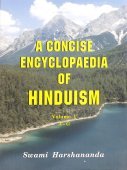Kaumodaki, Kaumodakī: 13 definitions
Introduction:
Kaumodaki means something in Hinduism, Sanskrit, Jainism, Prakrit. If you want to know the exact meaning, history, etymology or English translation of this term then check out the descriptions on this page. Add your comment or reference to a book if you want to contribute to this summary article.
In Hinduism
Shilpashastra (iconography)
Source: Red Zambala: Hindu Icons and Symbols | TrinityThe mace (gadā) is also called Kaumodakī which means the-stupifier-of-the-mind. The power of knowledge is the essence-of-life (prāṇa-tattva) from which all physical and mental powers come. Nothing else can conquer time and itself become the power of time.

Shilpashastra (शिल्पशास्त्र, śilpaśāstra) represents the ancient Indian science (shastra) of creative arts (shilpa) such as sculpture, iconography and painting. Closely related to Vastushastra (architecture), they often share the same literature.
Purana and Itihasa (epic history)
Source: archive.org: Puranic EncyclopediaKaumodakī (कौमोदकी).—The club of Śrī Kṛṣṇa. It is mentioned in Mahābhārata, Ādi Parva, Chapter 224, Stanza 23, that this club was given to Śrī Kṛṣṇa by Varuṇa the god of water, at the time of the burning of the forest Khāṇḍava.
Source: Cologne Digital Sanskrit Dictionaries: The Purana IndexKaumodakī (कौमोदकी).—The bludgeon of Viṣṇu reached Kṛṣṇa on the occasion of the siege of Mathurā.*
- * Bhāgavata-purāṇa VIII. 4. 19; 20. 31; X. 50. 11. [13]; Viṣṇu-purāṇa V. 22. 6.

The Purana (पुराण, purāṇas) refers to Sanskrit literature preserving ancient India’s vast cultural history, including historical legends, religious ceremonies, various arts and sciences. The eighteen mahapuranas total over 400,000 shlokas (metrical couplets) and date to at least several centuries BCE.
In Jainism
General definition (in Jainism)
Source: archive.org: TrisastisalakapurusacaritraKaumodakī (कौमोदकी) refers to a club and represents one of the nine gifts of the Gods given to Tripṛṣṭha, according to chapter 4.1 [śreyāṃsanātha-caritra] of Hemacandra’s 11th century Triṣaṣṭiśalākāpuruṣacaritra: an ancient Sanskrit epic poem narrating the history and legends of sixty-three illustrious persons in Jainism.
Accordingly:—“[...] The Vidyādharas, Jvalanajaṭin and others, mounted their chariots like lions a mountain-plateau. Then drawn by merit, the Gods gave Tripṛṣṭha a divine bow named Śārṅga, a club Kaumodakī, a conch Pāñcajanya, and a jewel named Kaustubha, a sword Nandaka, and a garland Vanamālā. They gave Balabhadra a plough named Saṃvartaka, a pestle named Saumanda, and a club named Candrikā. [...]”.

Jainism is an Indian religion of Dharma whose doctrine revolves around harmlessness (ahimsa) towards every living being. The two major branches (Digambara and Svetambara) of Jainism stimulate self-control (or, shramana, ‘self-reliance’) and spiritual development through a path of peace for the soul to progess to the ultimate goal.
Languages of India and abroad
Sanskrit dictionary
Source: DDSA: The practical Sanskrit-English dictionaryKaumodakī (कौमोदकी).—Name of the mace of Viṣṇu; Bhāg. 8.4.19; कौमोदकी मोदयति स्म चेतः (kaumodakī modayati sma cetaḥ) Śiśupālavadha 3.18.
See also (synonyms): kaumodī.
Source: Cologne Digital Sanskrit Dictionaries: Shabda-Sagara Sanskrit-English DictionaryKaumodakī (कौमोदकी).—f. (-kī) The club or mace of Krishna. E. kumudaka what gives the earth pleasure, here said to be Vishnu or Krishna, affixes aṇ and ṅīṣ; also kaumudī.
Source: Cologne Digital Sanskrit Dictionaries: Benfey Sanskrit-English DictionaryKaumodakī (कौमोदकी).—i. e. ku-modaka + ī, f. The club of Viṣṇu, or Kṛṣṇa, Mahābhārata 1, 8200.
Source: Cologne Digital Sanskrit Dictionaries: Monier-Williams Sanskrit-English DictionaryKaumodakī (कौमोदकी):—f. ([from] ku-modaka?), Name of the club of Viṣṇu or Kṛṣṇa (given to him by Varuṇa), [Mahābhārata i, 8200; Harivaṃśa; Bhāgavata-purāṇa etc.]
Source: Cologne Digital Sanskrit Dictionaries: Yates Sanskrit-English DictionaryKaumodakī (कौमोदकी):—(kī) 1. m. Krishna's mace.
[Sanskrit to German]
Sanskrit, also spelled संस्कृतम् (saṃskṛtam), is an ancient language of India commonly seen as the grandmother of the Indo-European language family (even English!). Closely allied with Prakrit and Pali, Sanskrit is more exhaustive in both grammar and terms and has the most extensive collection of literature in the world, greatly surpassing its sister-languages Greek and Latin.
Kannada-English dictionary
Source: Alar: Kannada-English corpusKaumōdaki (ಕೌಮೋದಕಿ):—[noun] the mace of Viṣṇu or Křṣṇa.
Kannada is a Dravidian language (as opposed to the Indo-European language family) mainly spoken in the southwestern region of India.
Nepali dictionary
Source: unoes: Nepali-English DictionaryKaumodakī (कौमोदकी):—n. the club of the god Vishnu;
Nepali is the primary language of the Nepalese people counting almost 20 million native speakers. The country of Nepal is situated in the Himalaya mountain range to the north of India.
See also (Relevant definitions)
Full-text (+1): Kaupodaki, Kaumodi, Kaupadaki, Kumodaka, Kaumoda, Gadadhara, Gada, Gadamudra, Samvartaka, Nandaka, Kaustubha, Candrika, Sharnga, Saumanda, Pancajanya, Vasudeva, Modaka, Narayana, Vanamala, Lal.
Relevant text
Search found 19 books and stories containing Kaumodaki, Kaumodakī, Kaumōdaki; (plurals include: Kaumodakis, Kaumodakīs, Kaumōdakis). You can also click to the full overview containing English textual excerpts. Below are direct links for the most relevant articles:
Garga Samhita (English) (by Danavir Goswami)
Verse 6.7.19 < [Chapter 7 - The Marriage of Śrī Rukmiṇī]
Verse 6.6.33 < [Chapter 6 - The Yādavas’ Victory When Śrī Rukmiṇī is Kidnapped]
The Agni Purana (by N. Gangadharan)
The Garuda Purana (by Manmatha Nath Dutt)
Chapter XLV - Characteristic marks of Shalagrama Stones (Shaligram) < [Agastya Samhita]
Chapter XIII - The prayer of Vishnu Panjaram < [Agastya Samhita]
Chaitanya Bhagavata (by Bhumipati Dāsa)
Verse 1.12.157 < [Chapter 12 - The Lord’s Wandering Throughout Navadvīpa]
The Vishnu Purana (by Horace Hayman Wilson)
Bhakti-rasamrta-sindhu (by Śrīla Rūpa Gosvāmī)
Verse 3.3.5 < [Part 3 - Fraternal Devotion (sakhya-rasa)]
Verse 3.2.10 < [Part 2 - Affection and Service (dāsya-rasa)]
Related products
